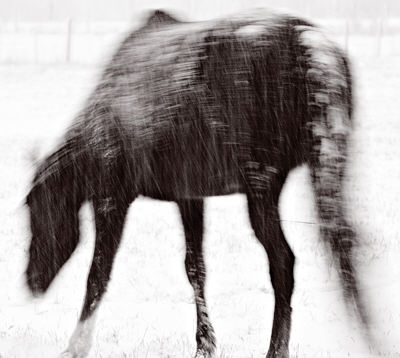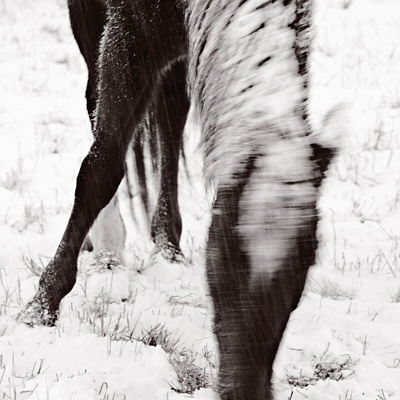I have been interested for some time in exploring possibilities for interesting texture in my photographs. One idea was to print on hand-tinted paper; that’s still under investigation — rather back burner at the moment. Another is encaustic medium, i.e. wax or something similar applied over a photographic print. I’ve made one small print by that method, and am definitely still experimenting. But photographing horses recently, I discovered a new strategy:
falling snow + moving horses = hatched textures.

The effect reminds me of etchings, although it’s actually more the reverse, in that the hatch lines are light, rather than dark.

As often happens, I didn’t really become aware of this until processing these images today (the outing was a week or two ago, but my computer has been down recently). I have, of course, photographed horses in falling snow before, but I just didn’t consciously think about the resulting texture and how it could be used. And it’s much more prominent in my current close-up approach than in previous work. Hopefully we’ll have more snow soon, so I can go back and play with this phenomenon more intentionally.

Made any serendipitous discoveries lately? How long did it take you to realize it?

Steve,
The first photo captures the feeling of frightening cold that I see here in Montana. Do you think you can do that again — that is, was the snow such that it will recur in your lifetime?
The second one has a kind of abstract quality to it — lines and shapes. There’s an awkwardness that makes it an interesting abstraction — the strong central head with the feet to one side, and then the strong white on the dark head, balancing, sort of, the feet. it’s definitely layered.
The last one is simply charming.
As for serendipitous discoveries — I seem to make them every day, but by the time I get to the computer, I’m brain-dead — can’t remember what I did let alone what new discoveries I made. But painting ten or twelve hours a day certainly brings out new stuff, at least for me.
Steve:
It’s one or the other or both in that you’re improving with each press of the button or I’m seeing more of your work, but you appear to be continually stepping from high to higher.
Now, it might be that photographing these horses may be like cooking rice – but I doubt it. There is always the matter of the given pose, pattern, detail and general sweep of the composition, and you have nailed them all in these images.
You ask about serendipity. Maybe not that, but sometimes, different and already established activities come together and mesh. Summer before last I was rubbing one color over another to get two-layered effects on fence slats. My colors and the tinted varnishes that I was applying were too harsh for the purpose and I set the matter off to one side. I came back to layering as a way to add another dimension to the surfaces in linkage pieces. I was using pieces of foamula to rub the paint on, but with predictable results. The I blew the dust off a little wooden brayer and began to roll oil paint onto the surfaces. The sense of tack and stipple produced by this method was right on and I went to bed with some small feeling of accomplishment. Serendipity? You be the judge.
June,
It was a pretty normal snow, so I should have a number of further opportunities this winter. It may look cold (depending on definitions), but it was actually no less than 20 F (-5 C). The main problems are fingers getting cold working the camera (I do have a pair of light gloves I can work in) and wet snow getting on the lens (the snow is dry and doesn’t melt on the camera if it’s cold enough). Or accidentally breathing and fogging things up.
or the batteries hating the cold and seizing up after 3 photos. I know the drill. I did a pleine aire painting here in Montana when it was 28 degrees — the snow went down my neck!
And breathing is definitely contraindicated — messes all kinds of things up.
You guys make me feel like a wimp.
The first picture is wild. An horse headed out into the nothing. It brings to mind strange creatures living in the northwest such as Bigfoot.
The different textures of snow against hair are sublime.
Steve–I really like these images. Of course, I have a little bit of a problem as a viewer, being so tied into the subject. It’s hard for me to look at a image of a horse without wonder “what breed? how’s their conformation?” But I particularily like the first one…Like Birgit said, the horse seems to be ducking down to head into another sphere…and the hatching changes the dimensionality of the body–makes it seem like a flat plane–a different continent seen from above rather than a body oriented in space.
As McFawn pointed out, there is something incongruent about the perspective of the first picture – the 3-D perception of an animal moving away and the hatch lines that suggest 2-Dimensionality.
McFawn,
Sorry I can’t enlighten you as to breed on this one, but at least it is a horse, rather than one of the sturdier but shyer burros also pastured there (see last image in a previous post).
That’s an interesting point, concerning the first image, about the texture inducing a sense of flatness, presumably by disrupting any (slight under this lighting) shading related to volume. At the same time, as you and Birgit note, the foreshortening clearly indicates the horse is facing away, making for a distorted shape. Perhaps that also reduces the reality and enhances the strangeness of the “sphere” it is moving to.
Hi I would love to purchase all 3 of these on canvas is that possible. Or as images so I can get them printed up onto canvas for my room. I live in Coolum Australia.
Thanks.
Julie Hourigan
julie,
I’ve never printed on canvas, but I’d be interested in giving it a try, if my printer can handle the size you want–it only goes up to 12″x18″ printed area. Otherwise, I can have it done elsewhere here, or make other arrangements with you. I’ll be in touch by email. I’m glad you like them!